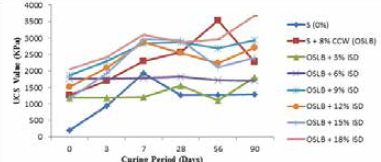Evaluation of Blends of Calcium Carbide Waste and Iron Slag Dust as Stabilizer in Flexible Pavement Construction
Keywords:
weak subgrade soil, flexible pavement, calcium carbide waste, iron slag dustAbstract
Stabilization techniques have often been used globally to enhance properties of weak subgrade materials for flexible pavement construction. This study evaluated the blends of calcium carbide waste (CCW) and iron slag dust (ISD) as an effective stabilizer. Subgrade material sourced from a section along Ota-Idiroko road was initially modified with CCW in different percentage replacements by weight (0, 4, 8, 12, 16 and 20%) and the resulting blends were subjected to Atterberg limit test to determine the blend with optimum plasticity index reduction which would be tagged optimum subgrade lime blend (OSLB). The blend of S + 8% CCW was tagged OSLB because it exhibited optimum plasticity index reduction (14.8 to 8.7%). The OSLB was thereafter blended by weight with ISD in the following percentage replacements (3, 6, 9, 12, 15 and 18%) in order to activate the pozzolanicity of ISD for strength enhancement. The resulting blends were subjected to Atterberg limit, Compaction, California bearing ratio (CBR) and Unconfined compressive strength (UCS) tests with the strength specimens cured for 0, 3, 7, 28, 56 and 90 days. Results showed that OSLB-ISD blends increased Plasticity index of OSLB (8.7 to 13.1%), reduced Maximum dry density to 6% ISD (1.66 to 1.52 Mg/m3) and Optimum moisture content to 9% ISD ( 17.2 to 14.5%). Increases in 7 days soaked CBR between 3 to 9% ISD (100.1 to 141.5%) and UCS between 9 to 18% ISD (2298.02 to 3096.27 KPa) were observed. The CBR and UCS results showed that the stabilized blends at 7 days curing upgraded natural subgrade to subbase and base for pavement construction.
Downloads





